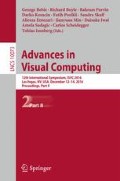Abstract
In this paper, a new effective method was proposed to recognize human actions based on RGBD data sensed by a depth camera, namely Microsoft Kinect. Skeleton data extracted from depth images was utilized to generate 10 direction features which represent specific body parts and 11 position features which represent specific human joints. The fusion features composed of both was used to represent a human posture. An algorithm based on the difference level of adjacent postures was presented to select the key postures from an action. Finally, the action features, composed of the key postures’ features, were classified and recognized by a multiclass Support Vector Machine. Our major contributions are proposing a new framework to recognize the users’ actions and a simple and effective method to select the key postures. The recognition results in the KARD dataset and the Florence 3D Action dataset show that our approach significantly outperforms the compared methods.
Access this chapter
Tax calculation will be finalised at checkout
Purchases are for personal use only
References
Baak, A., et al.: A data-driven approach for real-time full body pose reconstruction from a depth camera. In: Fossati, A., Gall, J., Grabner, H., Ren, X., Konolige, K. (eds.) Consumer Depth Cameras for Computer Vision, pp. 1092–1099. Springer, London (2013)
Hadfield, S., Bowden, R.: Kinecting the dots: particle based scene flow from depth sensors. In: IEEE Proceedings, vol. 58, no. 11, pp. 2290–2295 (2011)
Bagdanov, A.D., Del Bimbo, A., et al.: Real-time hand status recognition from RGB-D imagery. International Conference on Pattern Recognition IEEE, pp. 2456–2459 (2012)
Berretti, S., Bimbo, A.D., Pala, P.: Superfaces: a super-resolution model for 3D faces. In: Fusiello, A., Murino, V., Cucchiara, R. (eds.) ECCV 2012. LNCS, vol. 7583, pp. 73–82. Springer, Heidelberg (2012). doi:10.1007/978-3-642-33863-2_8
Gasparrini, S., et al.: Performance analysis of self-organising neural networks tracking algorithms for intake monitoring using kinect. In: IET International Conference on Technologies for Active and Assisted Living. IET (2015)
Shotton, J., et al.: Real-time human pose recognition in parts from single depth images. Postgrad. Med. J. 56(1), 1297–1304 (2011)
Yamato, J., Ohya, J., Ishii, K.: Recognizing human action in time-sequential images using hidden Markov model. In: IEEE Computer Society Conference on Computer Vision and Pattern Recognition, pp. 379–385 (1992)
Kellokumpu, V., Pietikäinen, M., Heikkilä, J.: Human activity recognition using sequences of postures. IAPR Conference on Machine Vision Applications, pp. 570–573 (2005)
Scholkopf, B., Smola, A.J.: Learning with Kernels: Support Vector Machines, Regularization, Optimization, and Beyond. MIT Press, Cambridge (2001)
Yang, X., Zhang, C., Tian, Y.L.: Recognizing actions using depth motion maps-based histograms of oriented gradients. In: ACM International Conference on Multimedia, pp. 1057–1060. ACM (2012)
Oreifej, O., Liu, Z.: HON4D: histogram of oriented 4D normals for activity recognition from depth sequences. In: IEEE Conference on Computer Vision and Pattern Recognition, pp. 716–723. IEEE (2013)
Gan, L., Chen, F.: Human action recognition using APJ3D and random forests. J. Softw. 8(9), 2238–2245 (2013)
Wang, J., Liu, Z., Wu, Y., Yuan, Y.: Mining actionlet ensemble for action recognition with depth cameras. In: Proceedings of the IEEE Conference on Computer Vision and Pattern Recognition, pp. 1290–1297 (2012)
Althloothi, S., et al.: Human activity recognition using multi-features and multiple kernel learning. Pattern Recogn. 47(5), 1800–1812 (2014)
Ohn-Bar, E., Trivedi, M. M.: Joint angles similarities and HOG2 for action recognition. In: IEEE Conference on Computer Vision and Pattern Recognition Workshops, pp. 465–470. IEEE Computer Society (2013)
Zhang, Z., et al.: A novel method for user-defined human posture recognition using Kinect. In: International Congress on Image and Signal Processing, pp. 736–740. IEEE (2014)
Gaglio, S., Re, G.L., Morana, M.: Human activity recognition process using 3-D posture data. IEEE Trans. Hum.-Mach. Syst. 45(5), 1–12 (2014)
Hsu, C.W., Lin, C.J.: Errata to “a comparison of methods for multiclass support vector machines”. IEEE Trans. Neural Netw. 13(4), 415–425 (2002)
Chang, C.C., Lin, C.J.: LIBSVM: a library for support vector machines. ACM Trans. Intell. Syst. Technol. 2(3), 389–396 (2011)
Seidenari, L., et al.: Recognizing actions from depth cameras as weakly aligned multi-part bag-of-poses. In: IEEE Conference on Computer Vision and Pattern Recognition Workshops, pp. 479–485. IEEE Computer Society (2013)
Devanne, M., et al.: 3-D human action recognition by shape analysis of motion trajectories on riemannian manifold. IEEE Trans. Syst. Man Cybern. 45(7), 1023–1029 (2014)
Acknowledgment
This work is supported by the National Natural Science Foundation of China under Grant No. 61403302 and the Fundamental Research Funds for the Central Universities No. XJJ2016029.
Author information
Authors and Affiliations
Corresponding author
Editor information
Editors and Affiliations
Rights and permissions
Copyright information
© 2016 Springer International Publishing AG
About this paper
Cite this paper
Ling, J., Tian, L., Li, C. (2016). 3D Human Activity Recognition Using Skeletal Data from RGBD Sensors. In: Bebis, G., et al. Advances in Visual Computing. ISVC 2016. Lecture Notes in Computer Science(), vol 10073. Springer, Cham. https://doi.org/10.1007/978-3-319-50832-0_14
Download citation
DOI: https://doi.org/10.1007/978-3-319-50832-0_14
Published:
Publisher Name: Springer, Cham
Print ISBN: 978-3-319-50831-3
Online ISBN: 978-3-319-50832-0
eBook Packages: Computer ScienceComputer Science (R0)

